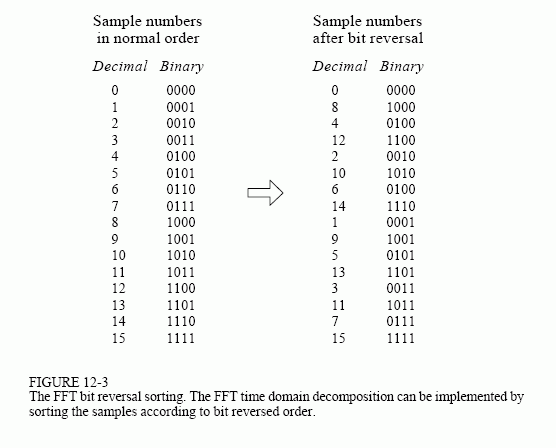Difference between revisions of "Fast Fourier Transform"
(cubic shmoobic) |
m |
||
| Line 5: | Line 5: | ||
The two diagrams below are from http://www.dspguide.com/ch12/2.htm and reveal a fundamental principle of how the linear and spectral are tied together at the most basic discrete level. The binary counting process (of stringing binary digits together to form a "number") yields a potentially infinite sequence of items and a simple geometric process allowing any one to be changed to the successive or previous item. | The two diagrams below are from http://www.dspguide.com/ch12/2.htm and reveal a fundamental principle of how the linear and spectral are tied together at the most basic discrete level. The binary counting process (of stringing binary digits together to form a "number") yields a potentially infinite sequence of items and a simple geometric process allowing any one to be changed to the successive or previous item. | ||
| − | If we consider a binary sequence as being able to be read from left to right, or from right to left, and that each binary sequence represents a specific point on a line, then as can be seen from the diagrams below, the pattern formed by iteration through the sequence when reading | + | If we consider a binary sequence as being able to be read from left to right, or from right to left, and that each binary sequence represents a specific point on a line, then as can be seen from the diagrams below, the pattern formed by iteration through the sequence when reading them backwards is perfectly multiplexed - i.e. we have the geometry of parallel computation where time is evenly distributed across the whole space at the same time, rather than starting at one end and moving to the other over time. |
[[Image:FFT1.gif]] | [[Image:FFT1.gif]] | ||
[[Image:F 12 3.gif]] | [[Image:F 12 3.gif]] | ||
Revision as of 03:43, 15 April 2008
The Fourier Transform is a mathematical transformation which switches a set of data between the linear and spectral domains. This transformation is extremely fundamental to our reality because these two complimentary domains, or views, of a system are common to all contexts of change and are at the heart of such complex problems as the wave-particle duality and the uncertainty principle.
One flavour of Fourier transform is the Fast Fourier Transform (FFT) which has been optimised from square to logarithmic efficiency by taking advantage of the fact that the process is essentially binary in nature. For a detailed description of how the FFT works, see http://www.dspguide.com/ch12/2.htm.
The two diagrams below are from http://www.dspguide.com/ch12/2.htm and reveal a fundamental principle of how the linear and spectral are tied together at the most basic discrete level. The binary counting process (of stringing binary digits together to form a "number") yields a potentially infinite sequence of items and a simple geometric process allowing any one to be changed to the successive or previous item.
If we consider a binary sequence as being able to be read from left to right, or from right to left, and that each binary sequence represents a specific point on a line, then as can be seen from the diagrams below, the pattern formed by iteration through the sequence when reading them backwards is perfectly multiplexed - i.e. we have the geometry of parallel computation where time is evenly distributed across the whole space at the same time, rather than starting at one end and moving to the other over time.









